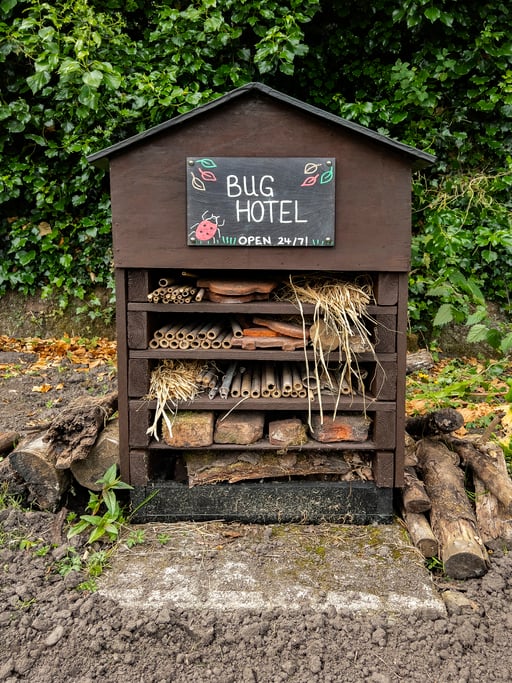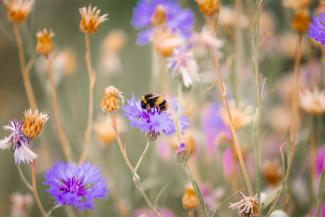Having a garden, or outdoor space, at home can be incredibly rewarding. Not only does it give you somewhere to bask in the sunshine on warm summer days, or somewhere for your children to explore without disrupting the feng shui of your living room but with a little bit of hard work, your garden can be another way for you to support your local environment.
Attracting wildlife to your garden is one of the best ways you can transform this space into a haven for birds, bees, insects and small animals which can support the ecosystem for years to come.

Common garden wildlife you might see
The UK is home to a variety of garden wildlife that you can attract into your garden. The most common types of garden wildlife include birds, bees, butterflies, hedgehogs, and foxes.
Birds are one of the easiest types of wildlife to attract to your garden and some of the most common garden bird that you’ll see are blackbirds, blue tits, robins, and sparrows. Additionally, bees are important pollinators that are essential to the health of our gardens as are butterflies who add an extra layer of beauty to your garden.
On a cuter side, foxes and hedgehogs are also common visitors to UK gardens. It is important to be careful around any animal or wildlife that you encounter in your garden as they can pose mild risks however you can still create a healthy and vibrant ecosystem that will benefit both you, your family, your garden and your local environment.
Wildlife aren’t pests and here’s why
For many people, garden wildlife are seen as pests and do all they can to rid their gardens of any animals or bugs however there are numerous benefits to having wildlife in your garden, from improving your mental health to contributing to the environment.
- Biodiversity: attracting wildlife into your garden can increase biodiversity in the local environment. When different species of animals visit your garden, it encourages plant diversity, creating a balanced ecosystem.
- Keep real pests at bay, naturally: some wildlife like birds and insects can serve as natural pest controllers in your garden. Ladybugs, for example, eat aphids, while birds feed on caterpillars and other garden pests.By encouraging some forms of wildlife into your garden, you can remove and prevent more harmful ones from living there.
- Nutrient cycling: wildlife also contributes to the nutrient cycle in your garden. Animals like earthworms help break down organic matter, which in turn helps to nourish your plants. Some research has shown that soils without earthworms can be 90% less effective at soaking up water which means that there is an increased risk in erosion and flooding. A good-quality soil will encourage earthworms and in turn, you’ll see the benefits in your plant health.
- Improve your wellbeing: spending time in nature has been shown to improve mental wellbeing, and having wildlife in your garden can help bring nature that bit closer to home. Opening your kitchen or living room doors onto your garden, make a cup of tea and listen to the birds in the mornin or watch the butterflies or bees in your flowers. Take the time to sit and enjoy nature from the comfort of your own home and feel the stresses of the day lift and improve your mood.
- Educate a younger generation: having wildlife in your garden presents lots of opportunities to learn more about wildlife and get children used to looking after their environment. Get children involved with bug hunts and counting different types of species or help them to build a bug hotel for little creatures to enjoy.

How can you encourage wildlife into your garden?
A lot of wildlife already exists in most gardens but in communities of new homes, they may need some extra encouragement to return and settle in your garden. This can be a simple process that requires little effort, yet yields numerous benefits. Here are some ways you can help to encourage wildlife into your garden:
- Plant native species: Native plants are vital for the survival of local wildlife. Native plants provide food and shelter for many types of animals and attract a variety of beneficial insects that help with pollination. Choose native species that are well-adapted to your region and require minimal maintenance. If you’re unsure where to get started, the Royal Horticultural Society has more information.
- Provide plenty of water: Water is an essential resource for all living things and wildlife may struggle in your garden without adequate water. You can easily provide a water source, such as a birdbath, pond, or even a simple dish of water, which will encourage wildlife to visit your garden. Make sure you keep the water clean and regularly top it up to ensure it remains as fresh as possible, particularly during warmer weather.
- Create habitat diversity: Animals need a variety of habitats to survive and thrive. Provide different habitats by creating various layers in your garden, such as trees, shrubs, and ground covers. Each layer provides a unique environment for different species, and by diversifying the habitats in your garden, you will attract a wider variety of wildlife and improve the landscaping of your garden too. You can find lots of ideas and ways to improve the habitats for local wildlife, depending on what you are trying to attract, on the RSPB website here.
- Incorporate shelter: Many species require shelter for nesting, roosting, or hibernating. Incorporating shelters, such as birdhouses, bat boxes, or even piles of leaves, can attract wildlife and provide a safe place for them to call home.
- Always check before you use chemicals: Pesticides and herbicides are toxic to wildlife and can harm the animals you are trying to attract to your garden. Avoid using chemicals in your garden and choose natural alternatives, such as compost and mulch, to help control weeds and pests.
Whether you’re looking to improve the health of your garden, want to do a bit more to sustain your local environment or just see more wildlife from your back door, encouraging wildlife into your garden space can be easy, affordable and fun.




